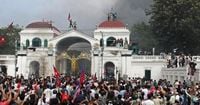Two months after the Gen Z uprising first electrified the streets of Kathmandu, its aftershocks continue to ripple through the heart of Nepal’s political landscape. What began as a youth-driven protest against corruption, nepotism, and political inertia has now morphed into a full-blown reckoning for the nation’s democratic institutions, social fabric, and even its economic prospects. As the dust settles, it’s clear that this isn’t just another episode in Nepal’s turbulent history—it’s a clarion call for deep, systemic change.
According to reporting by Republica, the immediate catalyst for this latest political ferment was the government’s announcement of parliamentary elections scheduled for March 5, 2026. In the weeks since, Nepal’s Election Commission (EC) has been inundated with an unprecedented surge in political party registrations. As of November 12, 2025, a staggering 23 new parties had applied for official status, though only three—the Shram Sanskriti Party, Gatisheel Loktantrik Party, and Nagarik Unmukti Party Nepal—had managed to clear the commission’s notoriously stringent hurdles and secure registration certificates. With these additions, Nepal now boasts 126 officially registered political parties, a testament to the growing appetite for alternative politics, especially among the nation’s restless youth.
But this newfound enthusiasm is colliding with the hard realities of Nepal’s political machinery. The EC, as reported by Republica, requires each aspiring party to submit a detailed statute, manifesto, regulations, and at least 500 supporter signatures from people unaffiliated with other parties. A minimum of 21 central committee members must also be present to authenticate the leadership. Many parties are stumbling at these bureaucratic hurdles—some can’t muster enough verified supporters, others lack complete documentation or leadership rosters. The EC has set a firm deadline of November 16, 2025, for all parties to complete their paperwork, warning that those who fail will be ineligible for the upcoming elections.
This procedural bottleneck is more than just a technicality. It’s a symptom of deeper institutional malaise. Since the restoration of democracy in 1990, Nepal has seen 32 governments in just 35 years—an average tenure barely exceeding a single year per administration. Not a single government has completed a full five-year term since 2008. While some might see this as evidence of lively democratic contestation, the reality, as noted by political scientist Samuel Huntington and echoed by local analysts, is one of “high participation but low institutionalisation.” Nepali citizens are politically active—voter turnout hovers around 65 percent—but the institutions meant to channel this energy into stable governance remain fragile and underdeveloped.
The Gen Z movement has thrown these contradictions into sharp relief. What started as a protest against corruption and poor governance quickly evolved into a broader indictment of the entire system. Public trust in institutions has eroded, battered by a culture of patronage, party-hopping politicians, and a relentless cycle of splits and mergers that rarely deliver substantive change. As The Kathmandu Post observes, “Leaders are frequently found ‘hopping and skipping’ between parties, shamefully presenting each reshuffle as a ‘revolutionary change’, while delivering little improvement in the daily lives of people.”
Economic frustrations have only fueled these flames. Nepal’s economy, long hamstrung by political dysfunction, offers scant opportunities for its burgeoning youth population. Youth unemployment stands at a sobering 21 percent, and more than 2,000 young Nepalis leave the country every day in search of work abroad. Remittances now make up over 25 percent of the nation’s GDP—a lifeline, yes, but also a sign of deep structural weakness. The Gen Z protests themselves have had a tangible economic impact, causing estimated losses exceeding Rs50 billion due to business closures, property damage, and supply chain disruptions. Tourism has plummeted and foreign investors are increasingly wary, compounding the country’s woes.
These economic wounds are not just numbers on a balance sheet—they’re lived realities for millions of Nepalis. The sense of despair is palpable, especially among the young, who see little hope for upward mobility at home. As one observer put it, “Today’s generation is also exhausted by an economy that offers little employment opportunity or upward mobility.” If left unaddressed, these grievances threaten to accelerate outward migration, erode public trust even further, and destabilize Nepal’s already fragile financial system.
The Gen Z uprising has also exposed and widened deep social and generational rifts. The younger, digitally connected generation is clamoring for change, while the older political establishment clings to the status quo. Violent incidents during the protests—including a mass prison break—have underscored just how brittle state institutions have become. The trauma of repeated instability, from the Maoist insurgency to the devastating 2015 earthquakes, lingers in the national psyche. With an interim government in place and parties expressing little confidence in Gen Z representatives, mistrust is running high ahead of the March 2026 elections.
Amid this maelstrom, the EC’s strict registration procedures serve as both a gatekeeper and a mirror. On one hand, they ensure that only serious, well-organized parties make it onto the ballot. On the other, they highlight the challenges facing Nepal’s aspiring political entrepreneurs—especially the young activists inspired by the Gen Z movement. Many new parties, like the Ujjyalo Nepal Party and Rastriya Gen-Z Party Nepal, have struggled to submit the necessary documents or gather enough verified supporters. Others, such as the Communist Party Nepal led by Netra Bikram Chand ‘Biplav’, have yet to provide key leadership and supporter information. The EC’s joint spokesperson, Prakash Neupane, stressed that “the commission thoroughly scrutinizes all documents attached to the application and sends the supporters’ signatures to the respective districts for verification.”
Yet, the sheer volume of new applications is a testament to the movement’s enduring impact. As Republica notes, “The post-Gen-Z movement wave of new party registrations reflects growing political awareness and demand for alternative politics, especially among the youth.” Whether these fledgling parties can overcome the legal and procedural hurdles in time for the elections remains to be seen, but their very existence signals a hunger for change that cannot be ignored.
Looking ahead, Nepal faces a daunting but potentially transformative crossroads. Rebuilding trust in politics will require a wholesale shift from patronage and personality-driven maneuvering to a culture of accountability, ethical conduct, and genuine performance. Political parties must democratize internally, empower younger leaders, and prioritize policy over personal gain. Economic reforms, too, are essential—targeted investments in technology, digital entrepreneurship, and human capital development could help reverse the country’s brain drain and restore hope for the future.
On the diplomatic front, Nepal’s chronic instability and frequent government changes have sown unpredictability, undermining confidence among key neighbors like India and China. A consistent, transparent foreign policy grounded in national consensus is urgently needed to restore Nepal’s standing on the world stage.
The Gen Z uprising is more than just a protest—it’s a generational demand for a new kind of democracy, one that delivers results, holds leaders accountable, and gives every citizen a stake in the nation’s future. Whether Nepal’s leaders can rise to meet this challenge remains the defining question of the current moment.

